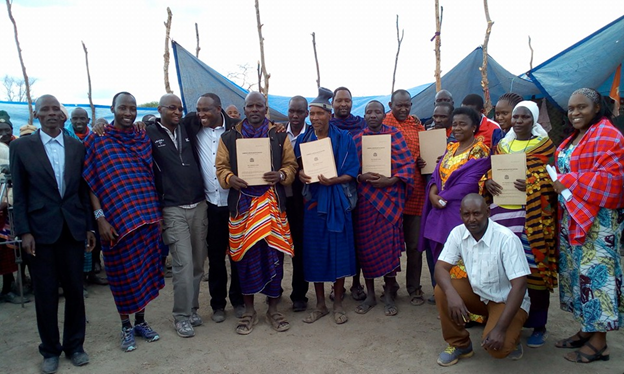|
Some of Tanzania’s last remaining hunter-gatherers, the Akie, were handed over land certificates at a ceremony in Kitwai village, Simanjiro District earlier this month. Local pastoralists were also granted land certificates, securing the largest track of prime grazing land for pastoralists’ livestock issued to date. Attended by the Assistant Commissioner for Lands, Northern Zone, and other distinguished government representatives, including Simanjiro’s Member of Parliament, the regional livestock officer as well as community members, the ceremony formally awarded two Certificates of Communal Right of Occupancy (CCROs) to Kitwai A village and two to Kitwai B village, providing a cumulative 144,501 hectares secured for either livestock grazing or hunter gatherer traditional use. Approximately 5,000 people living in these villages will benefit from this increased land security, protecting their livelihoods and their rights. “CCROs reduce conflicts over land use, promote equal access and ownership to land, and secure communal rights to land and natural resources,” explains Edward Loure, Simanjiro Programme Coordinator for the Ujamaa Community Resource Team, the organization pioneering this model for securing local land rights. “These latest CCROs will help ensure that the Akie as well as the local pastoralists have official and recognized rights to access, use, and manage their land in the way that they want to – and in most cases, in the way they always have, which is sustainably” Loure says. As part of the CCRO application process, villages need to establish formal land use plans, which includes agreeing on annual grazing calendars and traditional land uses in accordance with land capacity and conservation needs. Adherence to the land use plans will reduce cattle mortality caused by prolonged drought in the area and protect the natural environment through reduction of soil erosion caused by overgrazing. “The pastoral community will now enjoy greater connectivity thanks to proper land use planning and facilitation of CCROs, improving livestock health in the case of pasture management and livestock mobility,” remarked Nyika Shaushi, Kitwai Ward Councillor, at the handing over ceremony. At the ceremony, government official Baltazari Sulle recognized the large community effort involved in achieving the CCROs, and applauded the exemplary collaboration of all parties. “I was part and parcel of the whole process, in collaboration with UCRT field staff, that led to productive results which also enhanced mutual collaboration between UCRT and the district council” he said. Local Akie community beneficiary present at the ceremony, Laiharwa Lenae, echoed this sentiment in his remarks and noted the significance of the Akie gaining rights to their land, “we Akie have now obtained our first communal land certificate, giving us rights to control and manage our land.” UCRT is a local grassroots civil society organization of pastoralists and hunter-gatherers who over the last two decades have worked across northern Tanzania to help more than 75 communities secure over half a million hectares of land. Over the past five years UCRT has pioneered this unique approach to helping highly marginalized groups secure communal rights to land across northern Tanzania, working closely with both district and national government officials as well as with communities themselves. Local council and UCRT representatives said the ceremony commemorated their shared goals to support local people to manage and benefit from their land and natural resources in a peaceful and sustainable way. “This is a great milestone,” said Loure. “Now that these communities have legal occupancy and usage plans for the land, the next step is to provide training on monitoring techniques of the land and resources. Through effective monitoring and land use, additional training will help support these communities to benefit from their resources through development of fair contracts between local community and private sector.”
2 Comments
21/9/2016 16:23:23
i am seeing people holding certificate of ownership, the question is why several certificate in a community land?
Reply
Leave a Reply. |
Archives
March 2019
Categories |

 RSS Feed
RSS Feed
